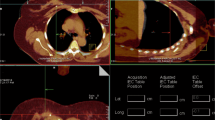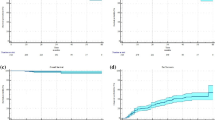Abstract
Background and purpose
To evaluate the feasibility and efficacy of external beam three-dimensional (3D) conformal accelerated partial breast irradiation (APBI) for selected patients with early breast cancer.
Patients and methods
Between 2011 and 2016, 72 patients were recruited for this prospective phase 2 trial. Patients were eligible for APBI if they had histologically confirmed breast cancer or pure ductal carcinoma in situ (DCIS), a tumor diameter ≤3 cm, clear resection margins ≥2 mm, no axillary lymph node involvement, no distant metastases, tumor bed clips, and were aged ≥50 years. Patients were excluded if mammography showed a multicentric invasive growth pattern, or if they had residual diffuse microcalcifications postoperatively, an extensive intraductal component, or vessel invasion. Patients received 3D conformal external beam APBI with a total dose of 38 Gy in 10 fractions in 1–2 weeks. The trial had been registered at the German Clinical Trials Register, DRKS-ID: DRKS00004417.
Results
Median follow-up was 25.5 months (range 1–61 months). Local control was maintained in 71 of 72 patients. The 3‑year local recurrence rate was 2.1% (95% confidence interval, CI: 0–6.1%). Early toxicity (grade 1 radiodermatitis) was seen in 34.7% (25/72). Late side effects ≥ grade 3 did not occur. Cosmetic results were rated as excellent/good in 96.7% (59/61).
Conclusion
APBI with external beam radiotherapy techniques is feasible with low toxicity and, according to the results of the present and other studies, on the way to becoming a standard treatment option for a selected subgroup of patients.
Zusammenfassung
Hintergrund und Ziel
Untersuchung der Verträglichkeit und Sicherheit der externen, 3‑D-konformalen akzelerierten Teilbrustbestrahlung (APBI) für ausgewählte Patientinnen mit einem frühen Mammakarzinom.
Patienten und Methode
Von 2011 bis 2016 wurden 72 Patientinnen in diese prospektive Phase-2-Studie eingebracht. Einschlusskriterien waren ein histologisch gesichertes Mammakarzinom oder DCIS, ein Tumordurchmesser ≤ 3 cm, tumorfreie Resektionsränder ≥ 2 mm, kein axillärer Lymphknotenbefall, keine Fernmetastasen, Tumorbett-Clips und ein Mindestalter von 50 Jahren. Die Patientinnen wurden nicht aufgenommen bei mammographischen Hinweisen auf ein multizentrisches Wachstumsmuster, bei postoperativ verbliebenen diffusen Mikrokalzifikationen, einer extensiven intraduktalen Komponente sowie bei Lymph- oder Hämangiosis carcinomatosa. Die Patientinnen erhielten eine 3‑D-konformale, externe APBI mit einer Dosis von 38 Gy/10 Fraktionen in 1–2 Wochen. Die Studie wurde beim Deutschen Register Klinischer Studien registriert (DRKS-ID: DRKS00004417).
Ergebnisse
Die mediane Nachbeobachtungszeit betrug 25,5 Monate (Spanne 1–61 Monate). Lokale Kontrolle bestand bei 71 von 72 Patientinnen. Die 3‑Jahres-Lokalrezidivrate war 2,1% (95%-KI 0–6,1%). Akute Nebenwirkungen (ausschließlich Grad-1-Radiodermatitis) traten bei 35% (25/72) auf. Spätnebenwirkungen ≥ Grad 3 gab es nicht. Das kosmetische Ergebnis wurde bei 97% (59/61) der auswertbaren Fälle als gut oder sehr gut eingeschätzt.
Schlussfolgerung
Die APBI mit einer externen 3-D-konformalen Radiotherapietechnik ist verträglich und effektiv und nach unseren bisherigen Ergebnissen und den Ergebnissen anderer Arbeitsgruppen auf dem Weg zu einer Standardtechnik für ausgewählte Fälle.

Similar content being viewed by others
References
Fastner G, Reitsamer R, Sedlmayer F (2014) Partial breast irradiation with intraoperative electrons versus conventional external whole breast irradiation for early breast cancer. Results of the ELIOT trial. Strahlenther Onkol 190:422–424
Haverkamp U, Moustakis C (2014) Calculation of the equivalent uniform dose for accelerated partial breast irradiation using the MammoSite applicator. Strahlenther Onkol 190:235–236
Vaidya JS, Bulsara M, Wenz F et al (2015) Pride, prejudice, or science: attitudes towards the results of the TARGIT-A trial of targeted intraoperative radiation therapy for breast cancer. Int J Radiat Oncol Biol Phys 92:491–497
Hepel J, Wazer DE (2015) A flawed study should not define a new standard of care. Int J Radiat Oncol Biol Phys 91:255–257
Leonardi MC, Maisonneuve P, Mastropasqua MG et al (2012) How do the ASTRO consensus statement guidelines for the application of accelerated partial breast irradiation fit intraoperative radiotherapy? A retrospective analysis of patients treated at the European Institute of Oncology. Int J Radiat Oncol Biol Phys 83:806–813
Veronesi U, Orecchia R, Maisonneuve P et al (2013) Intraoperative radiotherapy versus external radiotherapy for early breast cancer (ELIOT): a randomised controlled equivalence trial. Lancet Oncol 14:1269–1277
Strnad V, Ott OJ, Hildebrandt G et al (2016) 5‑year results of accelerated partial breast irradiation using sole interstitial multicatheter brachytherapy versus whole-breast irradiation with boost after breast-conserving surgery for low-risk invasive and in-situ carcinoma of the female breast: a randomised, phase 3, non-inferiority trial. Lancet 387:229–238
Yang TJ, Tao R, Elkhuizen PH et al (2013) Tumor bed delineation for external beam accelerated partial breast irradiation: a systematic review. Radiother Oncol 108:181–189
Jost V, Kretschmer M, Sabatino M et al (2015) Heart dose reduction in breast cancer treatment with simultaneous integrated boost: comparison of treatment planning and dosimetry for a novel hybrid technique and 3D-CRT. Strahlenther Onkol 191:734–741
Dellas K, Vonthein R, Zimmer J et al (2014) Hypofractionation with simultaneous integrated boost for early breast cancer: results of the German multicenter phase II trial (ARO-2010-01). Strahlenther Onkol 190:646–653
Strnad V, Hannoun-Levi JM, Guinot JL et al (2015) Recommendations from GEC ESTRO Breast Cancer Working Group (I): Target definition and target delineation for accelerated or boost Partial Breast Irradiation using multicatheter interstitial brachytherapy after breast conserving closed cavity surgery. Radiother Oncol 115:342–348
NSABP B‑39, RTOG 0413: A Randomized Phase III Study of conventional whole breast irradiation versus partial breast irradiation for women with stage 0, I, or II breast cancer. Clin Adv Hematol Oncol 2006; 4: 719–721
Cox JD, Stetz J, Pajak TF (1995) Toxicity criteria of the Radiation Therapy Oncology Group (RTOG) and the European Organization for Research and Treatment of Cancer (EORTC). Int J Radiat Oncol Biol Phys 31:1341–1346
LENT SOMA tables. Radiother Oncol 1995; 35:17–60
Harris JR, Levene MB, Svensson G, Hellman S (1979) Analysis of cosmetic results following primary radiation therapy for stages I and II carcinoma of the breast. Int J Radiat Oncol Biol Phys 5:257–261
Ott OJ, Hildebrandt G, Potter R et al (2011) Accelerated partial breast irradiation with interstitial implants: risk factors associated with increased local recurrence. Int J Radiat Oncol Biol Phys 80:1458–1463
Shah C, Antonucci JV, Wilkinson JB et al (2011) Twelve-year clinical outcomes and patterns of failure with accelerated partial breast irradiation versus whole-breast irradiation: results of a matched-pair analysis. Radiother Oncol 100:210–214
Polgar C, Fodor J, Major T et al (2013) Breast-conserving therapy with partial or whole breast irradiation: ten-year results of the Budapest randomized trial. Radiother Oncol 108:197–202
Polgar C, Major T, Fodor J et al (2010) Accelerated partial-breast irradiation using high-dose-rate interstitial brachytherapy: 12-year update of a prospective clinical study. Radiother Oncol 94:274–279
Livi L, Meattini I, Marrazzo L et al (2015) Accelerated partial breast irradiation using intensity-modulated radiotherapy versus whole breast irradiation: 5‑year survival analysis of a phase 3 randomised controlled trial. Eur J Cancer 51:451–463
Mozsa E, Meszaros N, Major T et al (2014) Accelerated partial breast irradiation with external beam three-dimensional conformal radiotherapy. Five-year results of a prospective phase II clinical study. Strahlenther Onkol 190:444–450
Olivotto IA, Whelan TJ, Parpia S et al (2013) Interim cosmetic and toxicity results from RAPID: a randomized trial of accelerated partial breast irradiation using three-dimensional conformal external beam radiation therapy. J Clin Oncol 31:4038–4045
Rodriguez N, Sanz X, Dengra J et al (2013) Five-year outcomes, cosmesis, and toxicity with 3‑dimensional conformal external beam radiation therapy to deliver accelerated partial breast irradiation. Int J Radiat Oncol Biol Phys 87:1051–1057
Coles CE (2016) Partial breast radiotherapy for women with early breast cancer: First results of local recurrence data for IMPORT LOW (CRUK/06/003). 10th European Breast Cancer Conference, Amsterdam, 9.–11.03.2016.
Peterson D, Truong PT, Parpia S et al (2015) Predictors of adverse cosmetic outcome in the RAPID trial: an exploratory analysis. Int J Radiat Oncol Biol Phys 91:968–976
Author information
Authors and Affiliations
Corresponding author
Ethics declarations
Conflict of interest
O.J. Ott, V. Strnad, W. Stillkrieg, W. Uter, M.W. Beckmann, and R. Fietkau declare that they have no competing interests.
Ethical standards
All procedures performed in studies involving human participants were in accordance with the ethical standards of the institutional and/or national research committee and with the 1964 Helsinki declaration and its later amendments or comparable ethical standards. Informed consent was obtained from all individual participants included in the study.
Rights and permissions
About this article
Cite this article
Ott, O.J., Strnad, V., Stillkrieg, W. et al. Accelerated partial breast irradiation with external beam radiotherapy. Strahlenther Onkol 193, 55–61 (2017). https://doi.org/10.1007/s00066-016-1066-9
Received:
Accepted:
Published:
Issue Date:
DOI: https://doi.org/10.1007/s00066-016-1066-9




